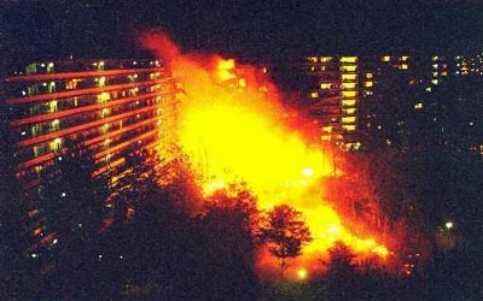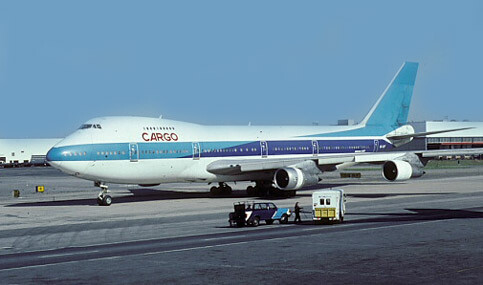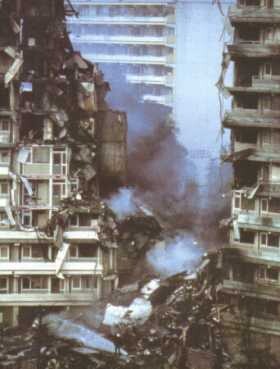The Electronic Intifada 4 October 2004

The aircraft crashed while attempting an emergency landing following the separation of two engines from the right wing of the aircraft. The aircraft impacted an apartment building vertically, killing 39 residents and four El Al crew members.
On Sunday, October 4, 1992, an El Al Boeing airplane carrying unspecified military cargo crashed into an apartment building in the Bijlmer neighbourhood of Amsterdam. Forty-three people directly lost their lives. More people have died since then, and many are still suffering from unidentified diseases.
The Dutch government denies any connection between Bijlmer residents’ health ailments and the disaster, though hundreds of people inhaled poisonous smoke from the burning airplane and the apartment building. Some of the El Al plane’s cargo is still unknown, but three of the four components of sarin nerve gas were present at the crash site. The flats contained asbestos and lots of plastics.
What is known is that the destroyed Boeing aircraft carried 75 tons of kerosene and 10 tons of chemicals. From the plane itself, at least 152 kg of depleted uranium counterweights are missing. Most probably, they burnt into particles. Because of the very sensitive cargo aboard the doomed aircraft, official investigations into the causes and repercussions of the 1992 crash have been shrouded in secrecy, denial and misinformation.

An EL AL Cargo plane similar to the one that crashed in Amsterdam.
Under a special bi-lateral agreement between the Netherlands and Israel dating from the 1973 Yom Kippur War, Israeli aircraft are granted special status at Amsterdam’s Schiphol Airport. El Al, Israel�s national airline, uses the airport to refuel planes en route between Israel and the United States. Often on a daily basis, El Al’s cargo planes land and take off, carrying munitions, military technology and other, often classified, loads.
One of El Al�s privileges at Schiphol are to undergo “different procedures” than other cargo carriers. The cargo of Israeli planes are checked on paper only, though frequently the airway bills do not match the cargo. Another privilege is known as “flying the El Al way.” Because of fear of terrorist attacks, El Al aircraft may land and take off as they see fit. This may account for the pilot’s choice of a route above a residential area on the evening of the fatal Octover 1992 crash. Schiphol’s air traffic control tower apparently had a different landing track in mind, but the El Al pilot tried to return to the airport following a different landing track that exposed the plane’s tail to buffeting winds. The pilot may have thought he had been hit by a missile; the landing track he chose was known to provide the best coverage against terrorists.
The cause of the plane crash was not an attack but sheer negligence: bad maintenance of the bolts that hold the engines to the wings. The plane’s bolts had suffered so much metal fatigue that two engines broke off from one wing. The pilots lost oil pressure attempting to stabilize wing flaps on the affected side of the plane. And because the plane was unevenly loaded with heavy cargo, it rolled over.

Delayed death came within 48 hours of the disaster, beginning with small pets, such as birds. The first dogs died 3 weeks later. Samples of deceased pets and guard dogs were analysed in laboratories other than those tasked with examining and analyzing humans remains. In contrast to physicians and forensic specialists, veterinarians have confirmed that the animals’ remains showed signs of poisoning.
A hidden epidemic gradually emerged among the surviving apartment block residents, professional and voluntary fire fighters, medical personnel, first aid workers, ambulance personnel, mounted police, their dogs and horses, army personnel, identification teams, Salvation Army volunteers and other relief workers. Journalists, too, have inhaled toxic and radioactive fumes, along with “disaster tourists,” workers who sorted out the remnants of the crash, crane drivers, suppliers of containers, construction workers, etc.
A cluster of serious human health problems became evident six months after the crash. Many residents complained of similar health problems, such as chest pains, joint pain, hair loss, skin rashes, unusual fatigue, vertigo, nausea, red skin spots, sore throat, nephritis, and cancer. Physicians did not know what to do about it. The most common diagnosis was Post Traumatic Stress Disorder (PTSD). The fact that relief workers who began spending significant time at ground-zero immediately after the disaster had the same health problems was ignored.
Many professional workers didn�t even rate a medical diagnosis; they were just ignored. The physicians treating fire fighters, police officers, and other service professionals denied or minimized the complaints of dozens of their patients. All these healthy men and women, in the prime of their lives, suddenly fell ill. As their health problems were not acknowledged, they had no one to whom to turn. Several committed suicide. Meanwhile, if asked about possible links between the crash and health ailments, Dutch officials knew only one phrase: “There is no connection with the disaster.”
In 1993, Annemie Ummels, a peace activist, and the Laka Foundation revealed that the El Al cargo airplane had been furnished with depleted uranium (DU) counterweights. Yet, the scientific spokesperson for the Dutch government, Keverling Buisman, stated that these counterweights stay intact during a crash and could not have burned in the fire afterwards. According to him, there was no possibility whatsoever that people could have inhaled DU.
The company that worked on salvaging the remnants of the aircraft had detected DU in the dust of the wreckage within 3 days. Also the Civil Aviation Authority (former RLD), the National Transportation and Safety Board (US) and the Federal Aviation Administration (AAA) all knew that not all DU counterweights from the doomed plane had been recovered. Meanwhile, radiation was also detected detected by a civilian working on airplanes parked in the same hangar as the damaged plane’s parts. The government managed to deny or ignore all of these issues for years.
Yet, one local politician decided that something had to be done for the residents, and asked for a medical investigation. The question was whether Bijlmer residents and others could have inhaled DU at ground-zero, and if there could be any connection with the inexplicable health problems of Bijlmer residents. The resulting investigation comprised an interview with five residents, phone calls with some Bijlmer physicians, and a survey among a bigger group of physicians. No one, except for one voluntary firefighter with a terrible rash on his foot due to standing in crash-related sludge, was diagnosed with a disease related to the disaster.
In 1994 the Amsterdam Research Service on Environmental Protection and Soil Mechanics (Omegam) took soil samples to search for DU. They found increasing pollution towards ground-zero, but below the health norm. But governmental institutions were losing their credibility, when it was revealed that Omegam had taken samples from already remediated soil.
Still, the government had to address the issue of the missing depleted uranium. In 1994, the scientific spokesman for the Dutch government admitted that the DU counterweights might all have burned after all. Despite this admission, Dutch officials, ministers and spokespersons from the aviation council would repeat the government�s earlier assurance that this was not possible for years to come.
Meanwhile, a physician in the Bijlmer noticed that many more miscarriages, stillborns, chromosomal aberrations and auto-immune diseases were occuring in his area. He compiled a complete dossier, but no health agencies responded. Also, the health minister denied a proposal for a health survey in 1996, supposedly because there was only one patient. The minister kept denying the proposal until 1997, when she finally promised to launch an investigation as soon as possible. After more than a year, a hotline was established at a hospital in 1999. A questionnaire, most about mental problems, had to be completed. The official result was that the complaints were considered too diffuse, offering no further options to investigate.
In 1999, the Visie Foundation took dust samples from the hangar where the aircraft�s parts were kept. It proved the presence of DU dust around the wreckage, which was later confirmed by governmental organisations. By then, the media were focusing on the disaster, reporting about the ongoing health problems and the missing DU.
Some began to question secret flights made by El Al in the days following the disaster, and soon journalists discovered fraudulent airway bills. Even the official flight route of the plane did not match eyewitnesses� reports. These and other discoveries finally forced the Dutch government to launch a parliamentary inquiry.
At the beginning of 1999 a Parliamentary Inquiry Commission was inaugurated to resolve a list of 89 so-called “theories.” Within a few months, the Commission had miraculously invalidated all of them. For example, they falsified the theory that the plane contained 1500 kilograms of DU, which was already known to be false since 1993, when Boeing declared that the plane contained 390 kilograms of DU. The Commission also managed to invalidate three theories about the disappearance of the cockpit voice recorder. Such results offered an easy way to say that all issues had now been resolved. Yet, both the recorder as well as most of the DU counterweights were still missing.
At one of the Commission�s hearings, watched by many on television, a tape was played. On the tape, an El Al operations worker said to Schiphol traffic control: “There were many explosives aboard, cartridges. There was poison aboard.” The traffic control officers then promised to keep this “under wraps.” A few hours later, however, a reassuring explanation of the conversation was offered: the El Al worker was reading from the airway bill New York-Amsterdam, not Amsterdam-Tel Aviv.
As for the issue of the missing uranium, the Commission did establish that part of it likely burned in the fire. However, it accepted the view of the national health agency that the resulting DU particles did not pose much of a health risk. The Dutch government spokesman, Keverling Buisman, stated under oath that smoking one cigarette was worse than inhaling DU dust in Bosnia and Kosovo.
The Commission�s final report was a reconstruction of the disaster made with the help of perjury by the police, aviation authorities, and politicians, characterized by professional silence, lies, deceit, manipulation and even intimidation. In fact, prosecution for perjury has been considered by the Commission at least four times, but thus far the minister of justice has prevented it.
After a discussion about the final report in parliament, the responsible ministers were held accountable, but none of them had to resign. The government promised to initiate an extensive examination of all health problems among residents and rescue workers by a team of specialists.
In total, 4804 persons applied for a medical examination; 1685 residents, 2765 aid workers and 356 KLM-employees who had worked in hangar 8. But in the summer of 2001 the Dutch government stopped the epidemiological and medical investigations among residents. The results of the research on aid workers and KLM personnel were presented in 2003. Finally, in July 2004 all examinations were officially closed, effectively burying all promises made to the parliament. The health minister stated that there was “no indication for further action.”
It is rather sinister that the Dutch government has closed the book on the Bijlmer disaster while so many people are still suffering health problems. The residents have never been examined for the effects of exposure to asbestos, PCBs from burnt plastics, the three components of sarin nerve gas, kerosene, or the rest of the chemical cocktail. Left alone by health authorities, residents with health problems have often had no other resort than commercial laboratories. Many are swindled by unprincipled technicians, who do very costly tests which are worthless without accreditation by the governmental health authorities. The tests are therefore not paid by health insurance.
Meanwhile, El Al planes continue to fly over the city of Amsterdam with classified cargo. On August 3, 2003, an El Al cargo aircraft lost parts of its body while landing at Amsterdam airport. The next day, the damaged plane was allowed to take off again. The Dutch air traffic authority had not even bothered to conduct a safety inspection.
Related Links

